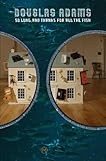 |
| Ash Tree Infected with EAB |
 |
| Emerald Ash Borer |
While Green and Black Ash trees are their preferable host, there is no Ash tree that is resistant to the pursuit of the EAB, however, the Blue Ash does hold off the longest in its resistance.
The life cycle of an EAB can take up to two years in its completion, depending on the health of the tree, the deposit of the eggs and temperature. Normally a female can lay up to 100 eggs in her two month life span and if one egg~laying female enters an Ash tree, 56% of these eggs are, on average, female; now, if they all lay eggs, within ten years you will have over 50 trillion Emerald Ash Borer's...enough to wipe out a nice sized forest of Ash trees.
The newly hatched larvae will burrow through the bark to the outer layer where they will feast on the new sapwood until the colder weather prevails, usually in the Fall. In the Fall, they shape into a "J~shape" larvae while excavating pupal chambers where they wait for Spring. In the Spring, they will eat their way out of the bark through D~shaped exit holes and are capable of flight upon emergence from the tree. Smaller larvae may require the summer to continue their growth rate and the larger larvae will emerge during the Spring.
Become aware of your Ash trees as you notice the symptoms that usually prevail such devastation. There will be a dieback of leaves in the upper third half of your tree upon onset and it progresses down over time. They may be vertical splits in the tree bark, S~shaped channels found underneath the tree bark, D~shaped exit holes in the bark usually indicates a recent emergence, heavy woodpecker activity, especially in the winter months, epicormic shoots (water sprouts) that appear at the trees trunk and worm~like larvae that can grow up to an inch long found under the tree's bark.
A professional Arborist will know the proper requirements in which to effectively and safely remove or treat your Ash tree, if you have any questions, I would recommend calling one in your local area for an assessment. As of today, only one treatment option has been approved by Canada and that is the use of TreeAzin, a biological insecticide, made from a natural product of Neem trees. It is delivered to the tree via a special tree injection system and may only be administered by professionals.
In looking for the proper tree service company, individuals should keep in mind that a good tree care specialist will offer a wide range of services, including, pruning, removal, fertilizing, cabling/bracing, pest control and others, and not just tree removal. NEVER use climbing spikes on healthy trees and NEVER remove a healthy tree...removal should ALWAYS be the last resort.




























































Such devastation from such a little pest. I'm thankful we don't have ash trees on our property, as the EAB isn't far away
ReplyDeleteSo amazing that such a little creature can do so much damage. I only recently learned of this seeing signs asking people not to bring "fire wood" from outside an area
ReplyDeleteThanks for sharing this. We have 750 acres of land with 100 acres of hardwood forest. When campers come to Manitoulin Island, some often ignore the "Do Not Bring Fire Wood from Off-Island" signs and insist on bringing their own. This is such a good reminder of why people shouldn't be doing this.
ReplyDeleteHonestly, all it does is fill me with such rage knowing we're losing the battle against these pesty buggers. Aside from that, what gets me next is how they leave our ash trees looking so putrid after eating through it. We need to stop this. And yes, they've stated we should stop transporting firewood, but who does that anyway, unless your a business?
ReplyDelete-Oscar Valencia